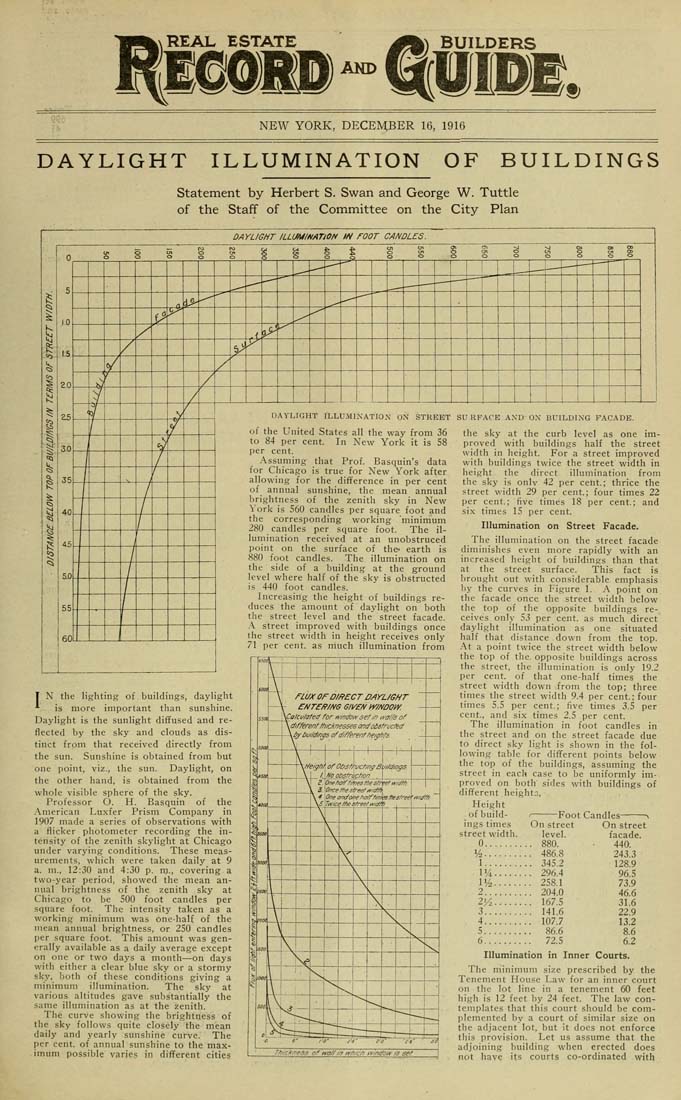Columbia University Libraries Digital Collections: The Real Estate Record
Use your browser's Print function to print these pages.
Real estate record and builders' guide: [v. 98, no. 2544: Articles]: December 16, 1916

Text version:
Please note: this text may be incomplete. For more information about this OCR, view About OCR text.
REAL ESTATE AND NEW YORK, DECEMBER 16, 1916 DAYLIGHT ILLUMINATION OF BUILDINGS Statement by Herbert S. Swan and George W. Tuttie of the Staff of the Committee on the City Plan DAYLIGHT ILLU.VIINATIO.N ON STREET of the United States all the way from 36 to 84 per cent. In New York it is 58 per cent. .^ssinning that Prof. Basquin's data for Chicago is true for New York after allowing for the difference in per cent of annual sunshine, the mean annual l>rightness of the zenith sky in New \ ork is 560 candles per square foot and the corresponding working 'minimum 280 candles per square foot. The il¬ lumination received at an unobstruced point on the surface of the- earth is 880 foot candles. The illuinination on the side of a building at the ground level where half of the sky is obstructed is 440 foot candles. Increasing tlie height of buildings re¬ duces the amount of daylight on both the street level and tlie street facade. .\ street improved with buildings once the street width in height receives only 71 per cent, as niuch illumination from I N the lighting of buildings, daylight * is more important than sunshine. Daylight is the sunlight diffused and re¬ flected by the sky and clouds as dis¬ tinct from that received directly from the sun. Sunshine is obtained from but one point, viz., the sun. Daylight, on the other hand, is obtained from the whole visible sphere of the sky. Professor O. H. Basquin of the .\merican Luxfer Prism Company in 1907 made a series of observations with a flicker photometer recording the in¬ tensity of the zenith skylight at Chicago under varying conditions. These meas¬ urements, which were taken daily at 9 a. m., 12:30 and 4:30 p. nj., covering a two-year period, showed the mean an¬ nual brightness of the zenith sky at Chicago to be SOO foot candles per square foot. The intensity taken as a working minimum was one-half of the mean annual brightness, or 250 candles per square foot. This amount was gen¬ erally available as a daily average e-xcept on one or two days a month—on days with either a clear blue sky or a stormy sky, both of these conditions giving a minimum illumination. The sky at various altitudes gave substantially the same illumination as at the zenith. Tlie curve showing the brightness of the sky follows quite closely the mean daily and yearly sunshine curve. The per cent, of annual sunshine to the max¬ imum possible varies in different cities SSOO . £000 SSOO 1 1 <^i500 1 i i V 'SOO \ 1 yi 1 \ 1 1 1 y nux OF D/ffECT D/iruGHr ^o/Ci//ofeef for n-mcfoiv oet ^r? ^j/Zsof \ 1 fferenf ffiicknesses and oisfn/cfed 'i/ii//M/!fs ofif/ffer^nf/teig/ffs \ . 1 1 , 1 i V \ 1 ofOdsf/ No odsfn 'ct/on \ \ /. OrKeff?es 'reetmdfff. \4 \0/?eff/?c/offe/?£7/rfm \S. Tmce^sfreefmif/ 'mt///> ' v^ \ ■ \ i - Nf" 1, ^ S. 1 j 1 .i 1._ . \,l — 1^ -J. .i J 1 ' <; tf' t-o- y-6' e'O' V-tf' jy T/p/cA-ryess of n^// //? fy/?/c/} r/ff>ifoPV /s set SURFACE AND 0.\ BUILDl.N'G FACADE. the sky at the curb level as one im¬ proved with buildings half the street width in height. For a street improved with buildings twice the street width in height the direct illumination from the sky is onlv 42 per cent.; thrice the street width 29 per cent.; four times 22 per cent.; five times 18 per cent.; and si.x times 15 per cent. Illumination on Street Facade. Tlie illumination on the street facade diminishes even more rapidly with an increased height of buildings than that at the street surface. This fact is lirought out with considerable emphasis liy the curves in Figure 1. A point on the facade once the street width below the top of the opposite buildings re¬ ceives only 53 per cent, as much direct daylight illumination as one situated half that distance down from the top. -At a point twice the street width below the top of the, opposite buildings across the street, the illumination is only 19.2 per cent, of that one-half tiines the street width down from the top; three times the street width 9.4 per cent.; four times 5.5 per cent.; five times 3.5 per cent., and six times 2.5 per cent. The illumination in foot candles in the street and on the street facade due to direct sky light is shown in the fol¬ lowing table for different points below the top of the buildings, assuming the street in eacli case to be uniformly im¬ proved on both' sides with buildings of different heights. Height of build----------Foot Candles--------\ ings times On street On street street width. level. facade. 0.......... 880. 440. %.......... 486.8 243.3 1.......... 345.2 128.9 l'/4........ 296.4 96.5 iy2........ 258.1 73.9 2.......... 204.0 46.6 2^........ 167.5 31.6 3.......... 141.6 22.9 4.......... 107.7 13.2 5.......... 86.6 8.6 6.......... 72.5 6.2 Illumination in Inner Courts. The minimum size prescribed by the Tenement House Law for an inner court on the lot line in a tenement 60 feet high is 12 feet by 24 feet. The law con¬ templates that this court should be com¬ plemented by a court of similar size on the adjacent lot, but it does not enforce this provision. Let us assume that the adjoining building when erected does not have its courts co-ordinated with